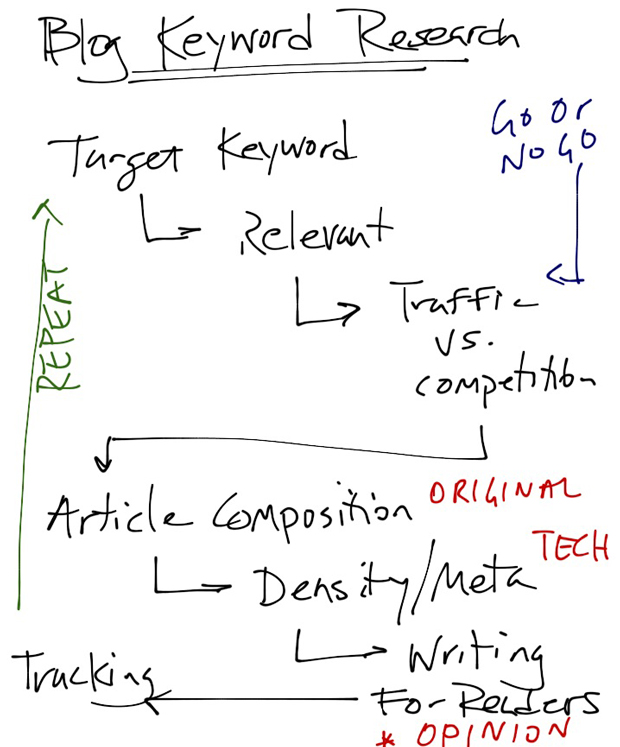This article is really a follow up to last week’s SEO article on how to get your article on the first page of Google. While that tutorial went through the process I go through to rank well on search engines at a blog level, I felt there was a need to dive a little bit deeper into content generation and planning to show how this affect the routines you go through on a weekly basis with your blog.
Let me preface by saying something very important.
I write blog articles for my readers, not for search engines.
While I know this is a line that has been beat to death over the years, it is an important one to remember as I do not do this every time I hit the publish button. There are topics and conversations that I have written about on my blogs that generate a lot of social or direct traffic that have little to no search engine benefit.
I cover topics, reviews and editorials that my readers want to read first. If I am able to tie in some optimized SEO to compliment those articles to make them perform well in search engine results, that is a bonus not a requirement. Far too often, I see blogs that focus on SEO with every single article…and quite frankly…they are boring.
My SEO Blog Article Cycle
As I was sitting down enjoying a cup of coffee the other day, I started to actually map out my process on the iPad. Here are my notes…
 Technology is awesome…I love my paperless life.
Technology is awesome…I love my paperless life.
Anyways, above is the cycle I go through when looking to generate articles that rocket to the top of search engine results…so let’s take a deeper look at the process.
Step 1: Target Keywords For Your Article
I personally have a list of high traffic keywords I have generated over the years that are all article worthy. If you are starting from scratch, there are two ways you can go about this.
- The Free Way – If you have a Google account, you have access to the Google Adwords keyword tool. This tool is actually used by Adwords advertisers to help them decide on which search keyword strings they want to target for the link ads. This is a huge asset for you as you can put in a keyword string (an example of mine would be “mountain biking”) and Google will pop out a list of related keywords and how often they are searched within a month. You then use the list of the higher volume searches as your article ideas.
- The Paid Way – I used to use the Google Adwords keyword tool until I picked up Market Samurai. While the Adwords tool is great, it was missing some information that I felt was necessary to carry out a really planned attack. When I put “mountain biking” Market Samurai, I am able to really narrow things down and find the best solution for my blog by weighing more factors than just search (how many people are paying for links in monthly volume is great for Adsense revenue) and I am able to track specific url performance on a daily basis.
Step 2: Is The Keyword Relevant?
As I mentioned before, I write articles for readers, so while there may be a ton of traffic available for “Schwinn Mountain Bikes”, the reality is that Schwinn is a brand that is carried in Wal-Mart and that is not relevant content for my blog (maybe a humorous article someday).
Once you have your list of possibles, you really need to ask yourself how relevant those keywords are to your audience. A lot of search engine traffic is great…but you want targeted traffic that increases your bottom line. A bunch of Wal-Mart bike purchasers are going to have zero interest in a review of a suspension fork that costs 5 times more than they paid for their bike.
Step 3: No or No Go Point: Traffic vs. Competition
Especially if you have a new blog, you will want to target keywords strings that have viable traffic with low competition. Market Samurai makes that an easy process by actually showing you those stats side by side, but you can also search on Google and take a look at the first page of results. Are you competing against the biggest in your niche or is there room for improvement?
When competition is low and traffic is pretty high, it really is a no brainer…get to writing. When traffic is high and competition is high, it doesn’t necessarily mean you shouldn’t cover that topic (could be really relevant and interesting for your readers) but you need to keep your expectations at a reasonable level until your site has established itself as a authority in your niche before you see high rankings.
At this point in the process, I make a decision whether to go with the article idea based off the previous data or to hit up something else.
Step 4: Article Composition and Writing
Now it is time to write the article. For this part of the process, I completely forget about SEO.
Your readers visit your blog to connect with your voice and style. They do not want another bland and boring rendition of popular keywords as you attempt to whore yourself out for search engine traffic. Write your article just as you normally would any other article on your blog. The uniqueness you bring to your content is the most important and you can always go back and adjust the content for search engines.
It is much harder to give life to a boring article than it is to give search engine optimization to an interesting one.
Step 5: The Tech Side Of SEO For Blog Articles
After you are completely happy with your blog article, it is time to go back and make sure everything is in line to perform its best on search engines.
- Content SEO – I use Scribe on my blogs to make sure my content is properly optimized for search engines. It tells me exactly which keywords I am targeting, how many times I should mention them in the article, how many links I need to have in the article and the best performing tags for that article. It basically takes all of research out for me and makes things a quick and easy process (that has shown results). By keeping keyword density at around 5.5% and under for primary keywords and linking about every 120 words, you are on the right track.
- Meta Titles and Descriptions – I custom write all of my meta titles and descriptions to insure search engines use my text instead of auto generated ones and to entice clicks on my links on the results list. It really is the only way to see success.
Step 6: Rescan – Writing for Readers and Sharing
As a general rule, search engine (SEO) topics can be rather bland. To overcome this and create articles my existing readers want to read as well, I inject as much personal opinion on the subject matter as I can to keep things interesting. At this part in the process, I read back over my article to make sure it is still interesting and that I have a defined opinion on the subject. If I do not have an opinion, I usually start over or pick another topic to write on.
If all looks good, I hit the publish button and we are off to the races. At that point, I make sure it hits Twitter, Facebook and my newsletter list to get as many eyes on the article as possible. If I have made it interesting enough, it is shared through social media outlets and linked to in other articles further increasing its weight in search engines.
Step 7: Tracking Progress Over Time
After the dust has settled, I load that specific URL into Market Samurai‘s Rank Tracking Tool to see how progress goes over the coming months. I use this information to tweak the process to get the best results I can for the next article that follows the cycle. If you do not track your results over time, how do you even know you are doing the right thing? You don’t…and you are just flying blind.
Step 8: Repeat The Process
The last thing you really need to do in the process is use the information from the last article to build on the next. Repeat the process by building on the success that you can measure through your tools and feedback from your readers. Comments, emails and other reader interaction is the best litmus test on how your article was received by your audience. You can combine that with the metrics you are gathering on the articles progress in search engines to refine and tune your process for the best success rate.
Above all…remember that you are writing your articles to connect with readers. If you are not accomplishing that…the rest of the process is worthless.
Tools Mentioned In This Article: Market Samurai and Scribe.


6 comments
Hi,
Good article, very clear about the main points of the process.
Cristina
Good follow up to your previous post. I agree, write for the reader then have SEO Scribe tweak it.
This was very simple and to the point..ranking is easy if you have the right tools to use..
“Black Seo Guy “Signing Off”
I already tried Scribe in a 30 day free-trial and I have no regrets using it. I optimized 15 of my posts that are now ranking high in the search engine especially Google. Using Scribe is like having an instant SEO assistant always telling us what’s wrong with our post and how we can improve it.
Scribe will also shows us variety of keywords to choose as primary keywords and secondary keywords of an article especially in the title
Thank you for the informative article. I agree with the “I write blog articles for my readers, not for search engines.” principle but having them SEO optimized will help those readers find your article.
Has anyone used SEO-Tool – Keyword Density Checker? It’s like the free and basic version of Scribe.